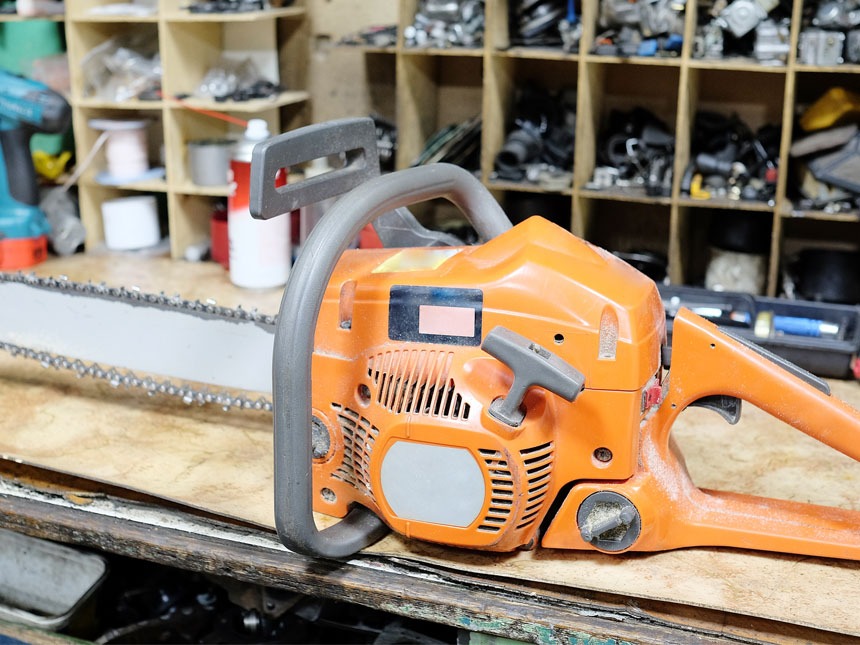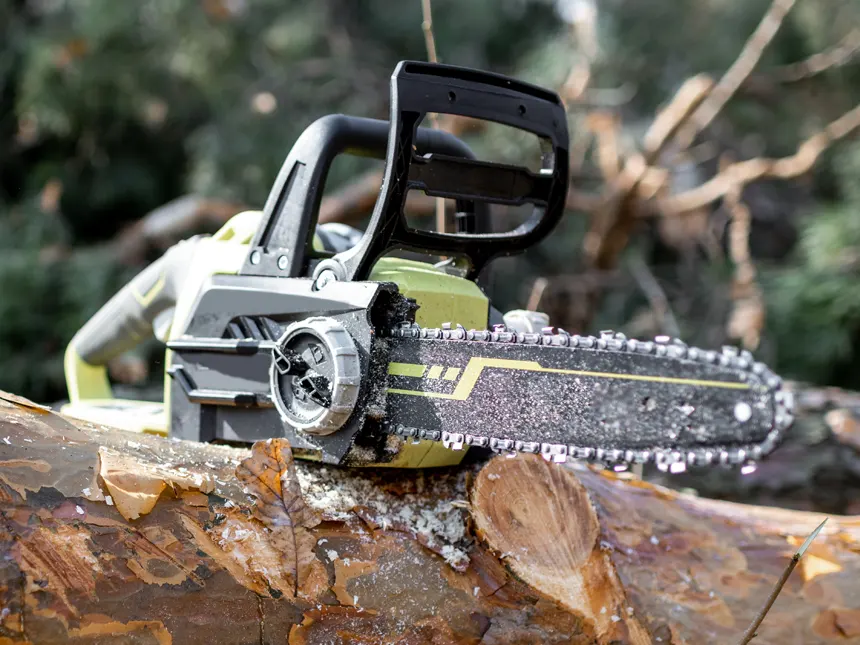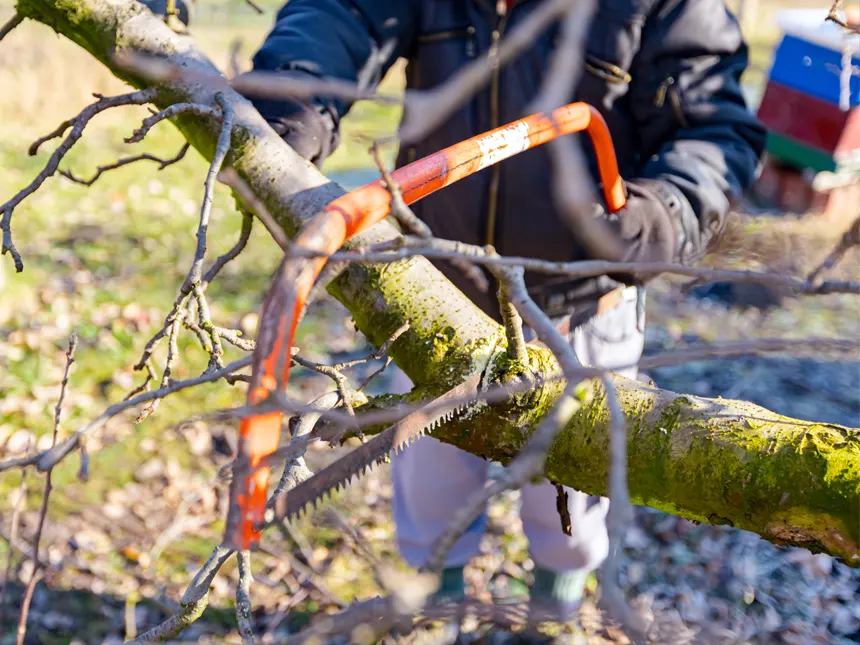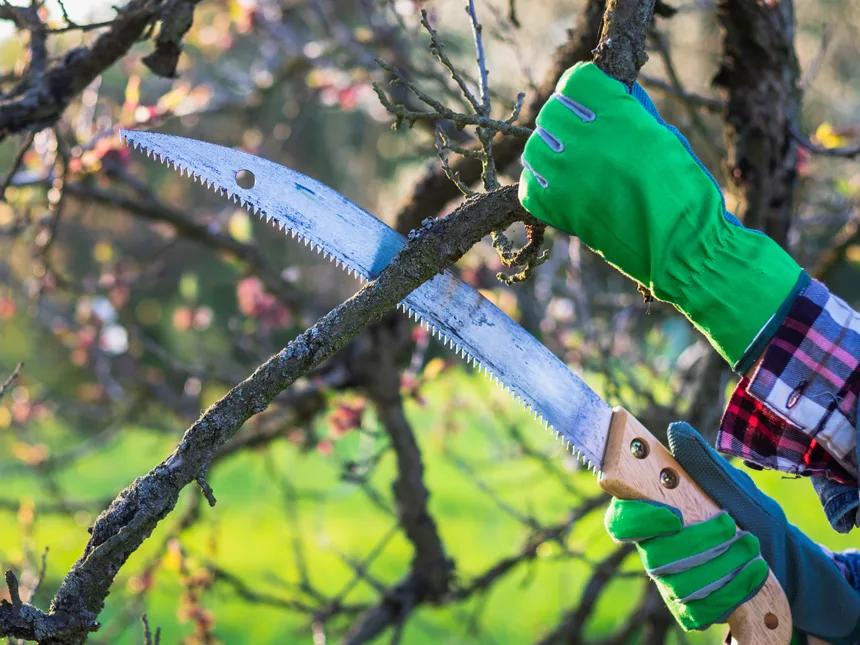5 Best Pruning Blades For Reciprocating Saws
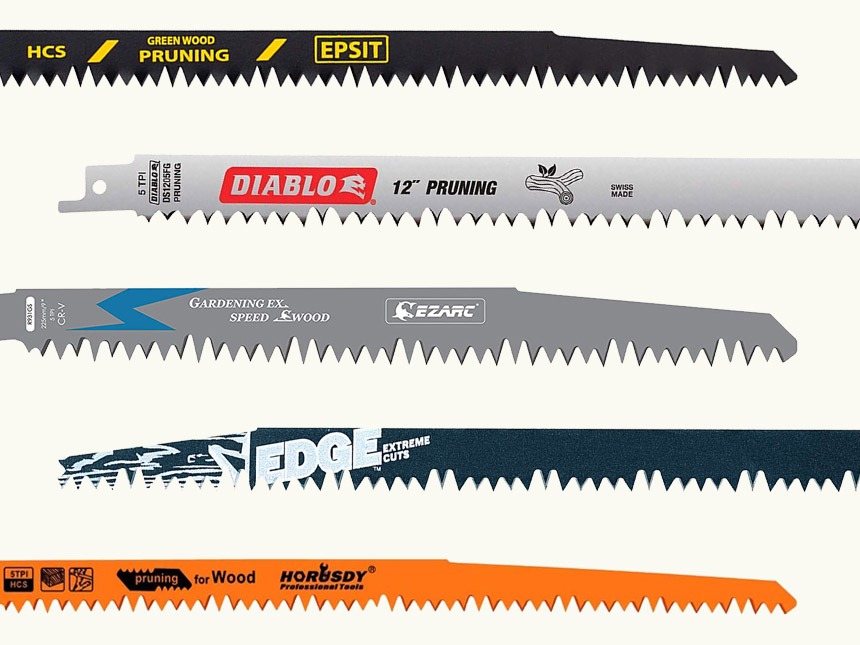
Timber Gadgets is reader-supported. We may earn a commission if you buy through the links on our site.
As one of the most versatile tools, reciprocating saws are a staple in many peoples’ workboxes. They can cut through almost any material, including metals, masonry, fiberglass, concrete, plaster, and more.
With the right blade, you can tackle any and all projects. These blades come in a variety of options, each specially designed for a different material. Despite how powerful recip saws are, choosing the right blade can still be the difference between phenomenal or mediocre results.
When pruning and/or working with wood, it’s important to choose a blade that’s designed for this purpose. Pruning blades are usually longer and thinner with a standard thickness around 0.035” and 8 – 11 TPI. The blade itself can be made from high carbon steel, high speed steel, or bi-metal.
If you’re unsure of what this means, don’t worry. It’s actually pretty simple to choose the right pruning blade for your reciprocating saw, and we’ll cover all of the characteristics mentioned above. We’ll also go over our top five picks for the best pruning blades.
| Image | Brand | Model |
|---|---|---|
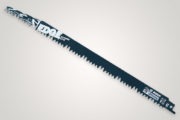 | Bosch | Edge Pruning |
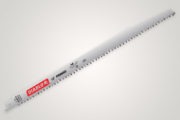 | Diablo | 12″ Pruning |
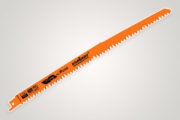 | Horusdy | Wood Pruning Blade |
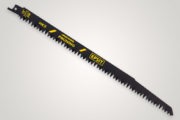 | EPSIT | Green Wood Pruning |
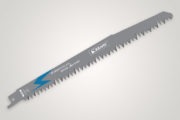 | Ezarc | Sabre Saw Blade |
Table of Contents
How To Choose A Pruning Blade
First and foremost, a pruning blade’s application should be your deciding factor. You need a blade that’s designed for pruning and wood cutting, so picking one that marketed towards fiberglass isn’t the best idea.
But to confirm that the blade is right for pruning (and you), there are several characteristics that you should look at. Chief among these are the length, teeth, and material of the blade, all of which we’ve dive into shortly.
Together, these elements determine which blades are best for pruning and which you should choose.
Length
Typically, a recip saw blade can range anywhere from 3 – 12”. The 6” and 9” are the most commonly sold, but standard lengths include 4”, 6”, 8”, 9”, and 12”.
There are pros and cons to short blades and long blades.
Shorter blades are more rigid, and therefore better if you’re going to be doing some aggressive cutting. Their stiffness provides straighter and more square cuts, which makes them the preferred length for plunge cutting, copper pipes, and thinner materials.
But longer blades are more flexible and, as a result of their larger surface area, dissipate heat more quickly. This give creates better flush cuts and is ideal for use on projects like demolition, pruning, and auto dismantling.
Keep in mind, the blade length should always be roughly 2 – 3” longer than the width of the material you want to cut. This helps reduce slipping, binding, and vibration. It also provides you with a greater range of movement.
Using a blade that’s too long results in increased wobble and vibration, slower cuts, and a potentially damaged blade. This means your project is either off schedule or your tools are wrecked, neither of which is a great outcome.
Blade width, shape, and thickness also play a part in how effective the blade will be:
- Width – Wider blades (3/4 – 1”) are more stable and better for heavy duty applications like demolition, auto dismantling, and even fire and rescue; thinner blades (1/2 – 3/4”) are more flexible and better for general purpose and finer cutting, such as detail work.
- Shape – Sloped blades are great for plunge cutting, while straight blades are better for edge cutting. Blades with a notched or sloped tip or semi-tapered back are versatile and can be used for either.
- Thickness – Thick blades (0.042 – 0.062”) are more durable and rigid, and therefore better for cutting thick and dense materials like nail-studded wood; standard blades (0.035”) are better for a variety of applications since they’re more flexible.
Just like you should pay attention to the length of your blade, you should also choose a blade based on its width, shape, and thickness for best results.
Each element of a blade— its length, width, shape, and thickness— is purposefully designed to make your project’s as easy as possible and tackle any material you might come across.
Teeth
When considering the teeth of a blade, look at the tooth pattern, tooth shape, and teeth-per-inch (TPI).
Most blades range from 3 – 24 TPI, which determines the blade’s cut speed and roughness. Lower TPI blades (3 – 11) cut quickly but can leave rough edges, which is why they’re best used for wood and demolition work.
Pruning blades tend to fall within this range, usually within 8 – 11 TPI, while general wood cutting blades are often labelled around 6 TPI.
Higher TPI blades (8 – 24) cut slowly but leave smooth edges, which is why they’re ideal for metal cutting and wood finish cuts.
Combination blades can have a variable TPI and are used for both wood and metal cutting. This is made possible because different parts of the blade each have an individual TPI. Changing to a different cut is as simple as repositioning the blade to the part with your desired TPI.
For example, a variable blade with 10/14 TPI. Using the alternating blade sections of 10 TPI and 14 TPI, you could cut through wood and metal, respectively.
At any given time, at least three teeth should be in contact with your cutting material. This ensures you keep control of your cut, while also reducing snagging and roughness.
Material
When it comes to picking out the right blade for your project, it’s also essential to match your blade’s material to what you’ll be cutting.
Not all blades can cut through every material you come across. Blades are specifically designed and constructed for a certain class or type of materials.
Using the wrong blade outside of the materials it’s been built to cut through will prematurely wear down or even break your blade.
As such, what the blade is made of is just as important as characteristics like the length and teeth. Some common materials blades are made from include:
- High Carbon Steel (HCS) – The most common blade material, HCS is softer and more flexible, allowing the blade to bend without breaking. Though HCS is the least durable material, it can still easily handle soft wood, particle board, and plastic.
- High Speed Steel (HSS) – This material is more durable and heat-resistant than HCS, but also less flexible and easily broken if bent. HSS blades are commonly used on hardwoods, aluminum, and non-ferrous metals.
- Bi-Metal – A combination of an HCS body and HSS teeth, this type of blade is both durable and flexible. Bi-metal blades are rightly one of the most popular types, and can handle demo jobs, auto dismantling, sheet metal, piping, and standard wood.
- Carbide-Tipped – These are bi-metal blades with carbide tips on each tooth, extending the blade’s cutting life 20x. They are ideal for cutting thicker thick metals, including cast iron, stainless steel, high-strength alloys, grade 8 bolts, and boron-reinforced auto pillars.
- Carbide Grit – Instead of teeth, these blades have an abrasive strip to cut through dense materials. They are often used on ceramic, cement, brick, marble, masonry, and hard metals like cast iron and fiberglass.
- Diamond – Instead of a carbide abrasive strip, these blade use diamond. These are the most expensive blade type, but are well worth it. They can cut through brittle material like glass and dense material like concrete without destroying the blade or material.
Employing the right blade type not only preserves the materials you’re working with, but also maintains and extends the life of your tools. Even if you don’t care about the materials, no project is worth ruining your blade.
For example, trying to cut glass with a carbide-tipped blade would break the glass and ruin your blade’s teeth. Similarly, trying to cut through stainless steel with an HHS blade would do nothing but stall the project and wreck your blade.
If you’re unsure about whether or not a blade can handle a specific type of material, research the material’s hardness in comparison to your blade. The blade’s cutting edge should always be harder than the material you’re using it on.
The Best Pruning Blade Reviewed
There are a wide variety of pruning blades available, but not every option meets expectations. We’ve reviewed performance, characteristics, prices, and more to find the best recip saw blades.
For quick reference and comparison, here are the typical characteristics of a pruning blade: longer, thinner, a standard thickness around 0.035”, 8 – 11 TPI, and a blade made of high carbon steel, high speed steel, or bi-metal.
With that in mind, here are our top five picks for the best pruning blades:
Bosch Wood Cutting Reciprocating Saw Blades RP125
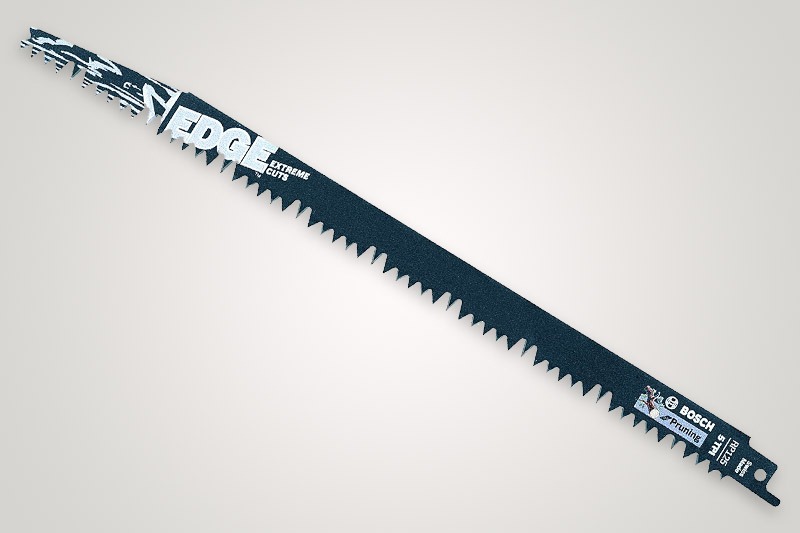
This five-piece set offers reciprocating saw blades designed for toughness, longevity, precision, convenience, and versatility. The blades are 12” long, 5 TPI, and made of bi-carbon steel with reinforced teeth.
Bosch claims that their Turbo-Teeth technology, performance-optimized blade geometry, and Swiss-made blade allows blades to last three times longer than standard recip saw blades.
These blades deliver superior performance for pro-cutting applications and are designed to take on extreme cuts for tough applications with ease.
Though primarily meant for pruning, this set is also cleared for light, medium, heavy, or demolition use on materials including wood with nails, metal, and even cinder blocks, stainless steel, fiberglass, and cement board.
Diablo Pruning Reciprocating Saw Blade
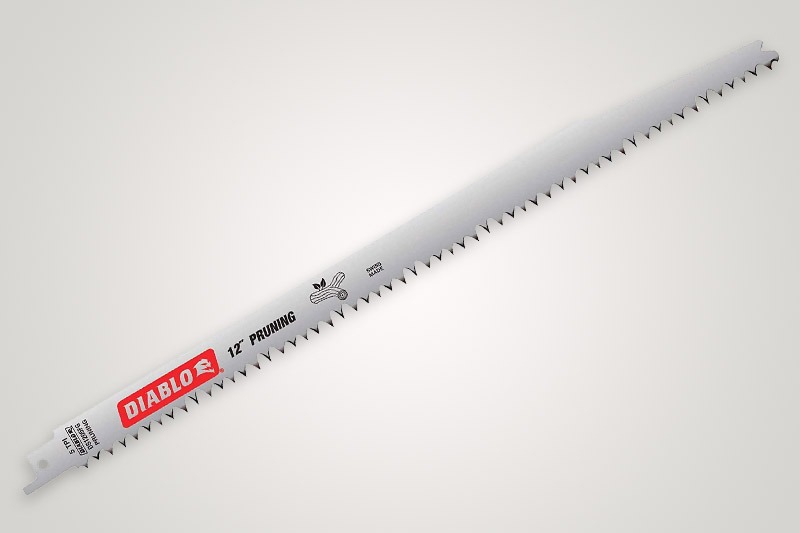
Also a five-piece set, the Diablo pruning recip saw blades are designed specifically for exceptional cutting performance in extreme pruning applications. The blades are 12” long, 5 TPI, and made of tempered steel.
The bi-directional tooth design and precision fleam ground teeth ensure fast and smooth cutting, while deep-seated gullets provide easy chip removal. The unique tip design allows for faster and easier plunging and the reinforced cutting edge lends durability to the blade.
They are not recommended for other applications such as cutting wood with nails.
Horusdy Wood Pruning Reciprocating Saw Blades
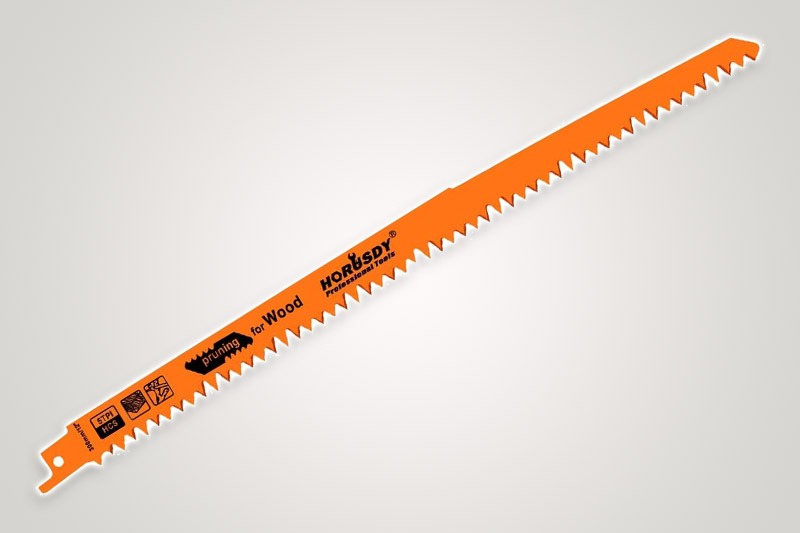
Horusdy blades are built using advanced alloys and tooth designs, creating smoother cuts and providing superior performance for outdoor wood and pruning applications. All five blades are 12” long, 5 TPI, and made of HCS.
The blade construction, ultra-hardened cutting edge, and reinforced sharp tip seamlessly create professional grade wood and pruning cuts. This saw set completes projects faster, cleaner, and more accurately.
As an added safety precaution, the blades come in a durable, clear plastic storage box that can only be opened if pulled. Shaking, banging, or otherwise jostling the case around won’t release the blades, keeping them carefully locked away until you need them.
Horusdy blades work with all major reciprocating saw brands, including DeWalt, Makita, Mailwaukee, Ridgid, and more.
Epsit Reciprocating Saw Wood Pruning Blades
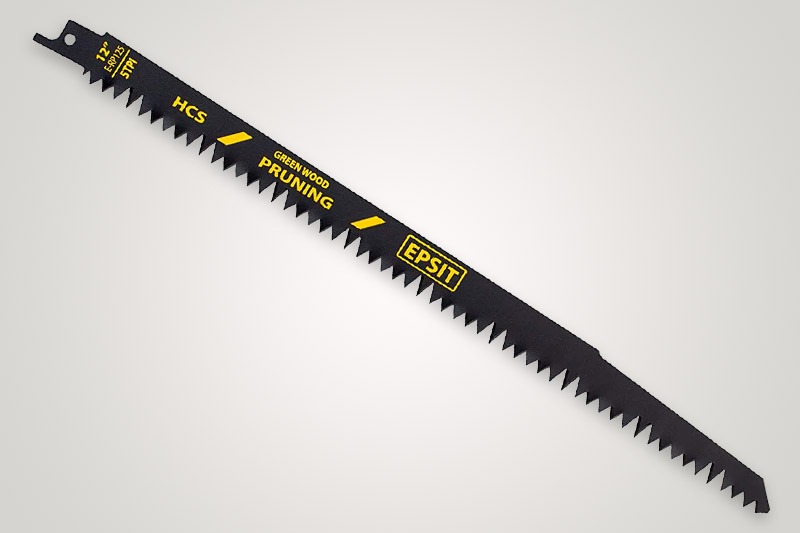
This three-pack combines quality features with practical design, resulting in reliably superior performance and blades that last two times longer than other recip saw blade sets.
The blades are 12” long, 0.,06” thick, 5 TPI, and made of high carbon alloy steel.
Laser-quenching ensures your cutting edge stays sharp, while precision ground teeth produce fast, precision cuts. Staggered teeth make pruning work effortless and smooth. Deep-seated kerf makes for easy chip removal.
Though versatile among pruning applications, these blades are best suited for green woods, timbers, and tree branches that are between 0.9 – 9.5” thick.
Epsit blades have a 1/2” universal shank and are compatible with all major reciprocating saw brands.
Ezarc Wood Pruning Reciprocating Long Lifetime Sabre Saw Blades
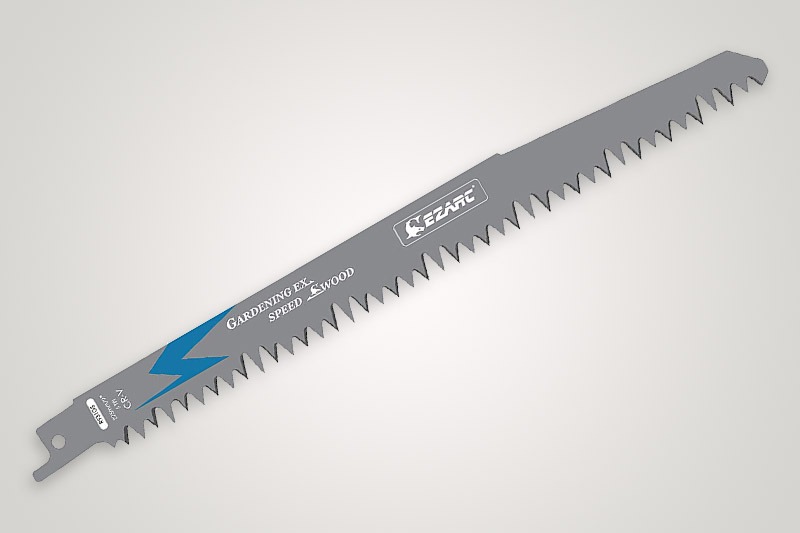
This five-piece set of blades offers best-in-class pruning ability that effortlessly prunes your trees and other outdoor foliage, giving your projects a professional edge without the higher cost. The blades are 12” long, 0.05” thick, 5 TPI, and made of heat-treated chrome vanadium (CR-V) steel.
They have a longer lifespan than regular HCC steel blades and are durable across all wood and pruning applications. Combined with a ground sharp teeth geometric design, cuts are quick, easy, and smooth.
Besides being ideal for garden and tree pruning, these blades are also suited to cutting wood and PVC plastic piping.
Ezarc sets come with a universal shank, ensuring their wood Sawzall blades fit all reciprocating saw tool brands, including DeWalt, Bosch, Milwaukee, Black & Decker, and more.
Frequently Asked Questions
This section is meant to answer some of the most common questions regarding pruning blades and reciprocating saws.
Absolutely! Just be sure to use a quality pruning blade. Most pruning blades have between 8 – 11 TPI (teeth per inch). The more teeth, the slower the blade cuts but the smoother the finish. Also, choose an appropriate length for the size of branches you’re pruning!
Yes, you can use a reciprocating saw to cut tree limbs. I recommend using a blade around 12-inches in length, with less than 11 TPI (teeth per inch) for cutting branches.
The ideal number of teeth per inch is around 10. Most pruning blades are between 8 – 11 TPI, with general purpose blades being around 6 TPI. The few number of teeth, the faster the blade will cut. However, blades with higher TPI leave a smoother finish.
This depends on the reciprocating saw and the length of the blade you’re using. Some brands recommend staying under 12 inches in diameter to keep from overworking the motor. Likewise, the length of the blade determines how thick of a branch you can cut too. Most reciprocating saws can cut a branch up to 12 inches in diameter, provided the blade in long enough.
My Final Recommendation
All five of these blades would easily accomplish your pruning projects and other light woodwork. Not only do they hold up to manufacturer claims, but they also consistently go beyond buyers’ expectations.
These pruning blades have been extensively reviewed and vetted by both professionals and everyday DIYers. They’re suitable for a variety of tasks and offer the best combination of flexibility, durability, and longevity.
Based on the pruning blades themselves and feedback from buyers, here are our final recommendations for the blades that are the best overall and offer the best value.
Best Overall – Bosch Wood Cutting Reciprocating Saw Blades RP125
This five-piece set rises above the rest based on its superior construction, durability, and versatility. Made of bi-carbon steel and equipped with advanced cutting technology, the Bosch saw blades offer users the best performance both in terms of pruning applications and other uses.
Performance-optimized blades and geometry come together to consistently and meticulously deliver efficient, precise, and performance-grade cuts. This set clears material more quickly and stays sharper longer than competitors.
If you want the best pruning reciprocating blades on the market, then look no further than Bosch’s set.
Best Value – Ezarc Wood Pruning Reciprocating Long Lifetime Sabre Saw Blades
Though all of the blade sets are reasonably priced and near each other in cost, the Ezarc five-piece set offers more value for a better price than the other blades reviewed. Though less versatile than some blades, it excels at its primary purpose: pruning and wood cutting applications.
Its durability and efficiency is supported by the overwhelmingly positive feedback from users. This set is consistently reviewed and voted as one of the best recip pruning saw sets available, as evidenced by the thousands of positive reviews online. In comparison, even our vote for best overall only has approximately 500 reviews.
If you’re looking for premium performance at a reasonable price, then the Ezarc pruning saw blade set is the perfect choice.
By the way, if you’re in the market for a new reciprocating saw, check out our review of the 3 best cordless reciprocating saws for trimming tree branches.

